Refractive error occurs when the parallel rays of light coming from infinity are not focused at the sensitive layer of retina resulting in blurred images for the patient.
Refractive errors are broadly classified into four types:
- Hyperopia
- Myopia
- Astigmatism
- Presbyopia
Hyperopia
When the rays of light coming from a distance are focused behind the retina with the accommodation being at rest, then it results in Hypermetropia or long-sightedness.
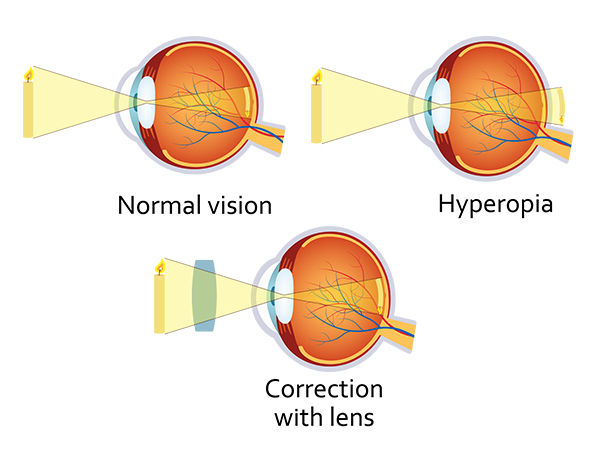
Hyperopia is classified into four types, as mentioned below:
- Axial – It occurs due to axial shortening of the eyeball. It can be developmental or pathological.
- Curvatural – It occurs when the curvature of the lens is flatter than normal.
- Index – It is due to a change in the refractive index of the lens, resulting in Hyperopia
- Positional – It occurs due to a change in the position of the lens.
- Consecutive – It occurs following refractive surgery and cataract surgery.
Variation of Hyperopia with age
At birth, the eyeball is relatively short, resulting in a significant amount of Hyperopia, which gradually gets corrected at the age of 5yrs.
After 50 yrs of age, the Hyperopia occurs again due to changes in the crystalline lens.
Symptoms
- Asymptomatic in young patients, which is due to mild accommodative effort.
- Asthenopic symptoms include tiredness of the eyes, frontal headache, watering and mild photophobia.
- Defective vision
If the Hyperopia is not corrected, it can result in the following complications:
- Recurrent styles, chalazion
- Accommodative squint
- Amblyopia – lazy eye
- Predisposition to develop angle-closure Glaucoma

Treatment
Spectacle correction is given using a convex lens. A safe and easy method of correcting Hyperopia is spectacles.
Contact lenses
Refractive surgeries are also one of the options available.
Myopia
Myopia or shortsightedness, a type of refractive error in which rays of light from infinity are focused in front of the retina when accommodation is at rest.
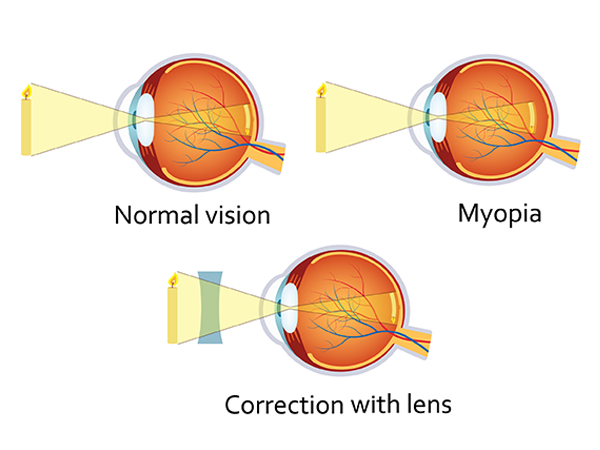
Types of Myopia
- Axial Myopia
This condition happens due to an increase in the anteroposterior length of the eyeball.
- Curvatural Myopia
It is caused due to increased curvature of the cornea, lens or both.
- Positional Myopia
Positional Myopia occurs due to the anterior placement of the crystalline lens.
- Index Myopia
Index Myopia occurs due to a change in the refractive index of the lens.
- Myopia due to excessive accommodation of the lens.
Symptoms and signs
- Poor vision for distance
- Asthenopic symptoms
- Half shutting of eyes
- Decrease in outdoor activities in children
- Prominent eyeballs
- Anterior chamber is deep
- Large pupils
- Pathological Myopia occurs when the refractive error is more than 6 diopters.
Complications of Pathological Myopia
- Retinal detachment
- Complicated cataract
- Vitreous haemorrhage
- Choroidal haemorrhage
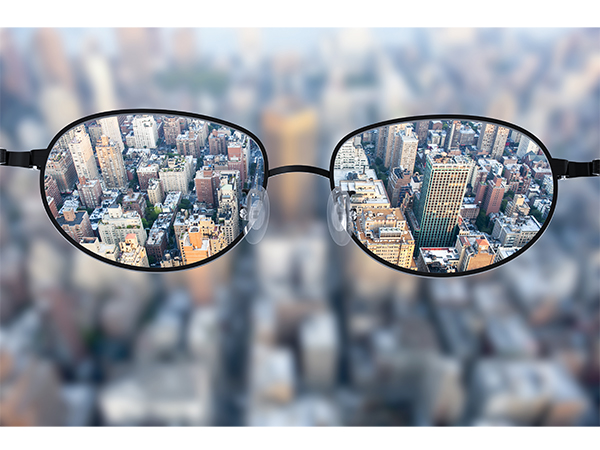
Treatment options
Spectacle correction by prescribing the appropriate concave lens after performing cycloplegic refraction
- Contact lens
- Refractive surgeries
Astigmatism
Astigmatism is a type of refractive error when the refraction varies in the different meridians of the eye.
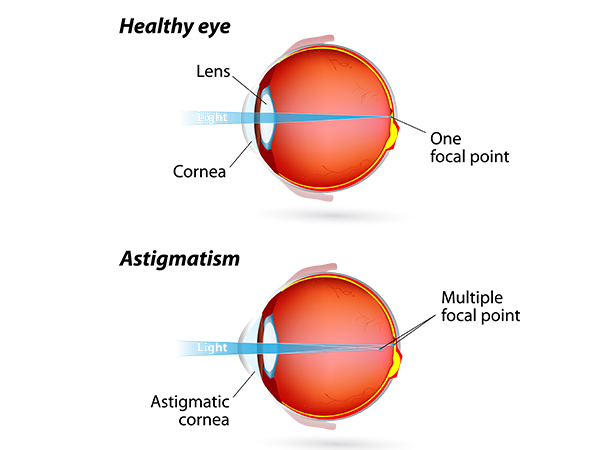
Astigmatism can be classified based on:
- Curvature: It occurs due to abnormalities of the curvature of the lens.
- Positional: It occurs due to a change in the position of the lens.
- Index: It occurs due to the variable refractive index of the lens in different meridians.
- Retinal: It caused due to oblique placement of the macula.
Symptoms and signs
- Blurred vision
- Asthenopic symptoms
- Elongation of objects proportionate to the degree of Astigmatism
- Head tilt
- Different power in two meridians
- Tilted disc
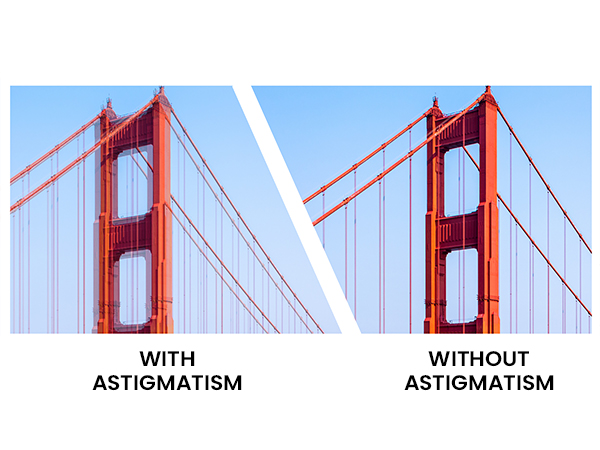
Treatment options
- Optical treatment
- Phototherapeutic keratectomy
- Surgical treatment
Presbyopia
Presbyopia is not a refractive error but a condition of physiological insufficiency of accommodation leading to a progressive fall in near vision.
This is faced by the patients above 40 years, as the near point of accommodation recedes after that age.
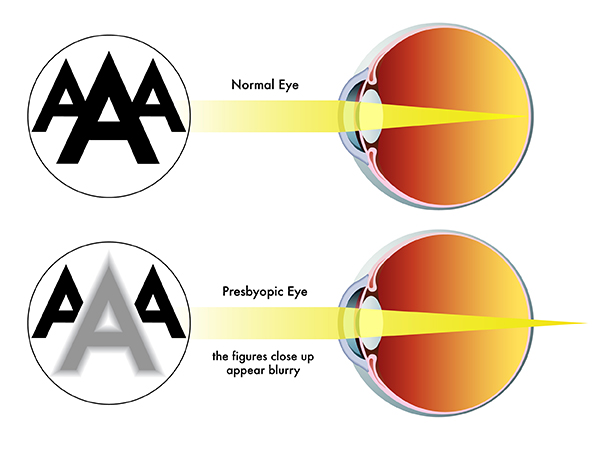
Symptoms
- Difficulty in near vision
- Asthenopic symptoms
- Intermittent diplopia
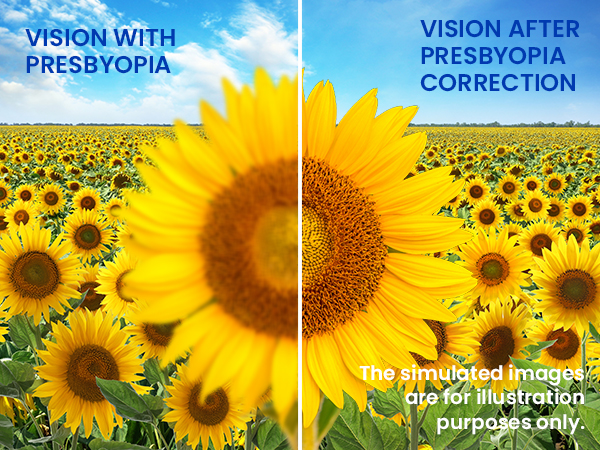
Treatment
- Optical treatment by prescribing the appropriate convex lenses
- Mono-vision contact lens
- Multi-focal contact lens
- Refractive surgeries
CONCLUSION
With the adequate facility, each individual must go in for regular eye checkups to know about their eye health and power. Changes in glasses or contact lenses are necessary, but they must not be done without an ophthalmologist’s approval along with the optometrist.
DISCLAIMER: THIS BLOG/WEBSITE DOES NOT PROVIDE MEDICAL ADVICE
The Information including but not limited to text, graphics, images and other material contained on this blog are intended for education and awareness only. No material on this blog is intended to be a substitute for professional medical help including diagnosis or treatment. It is always advisable to consult medical professional before relying on the content. Neither the Author nor Star Health and Allied Insurance Co. Ltd accepts any responsibility for any potential risk to any visitor/reader.





